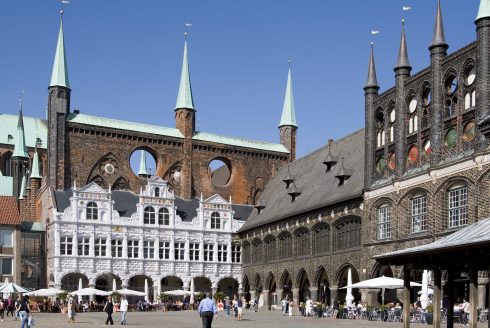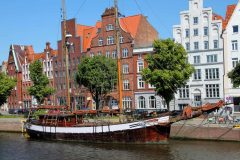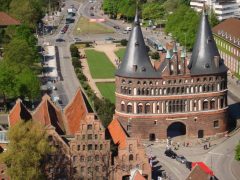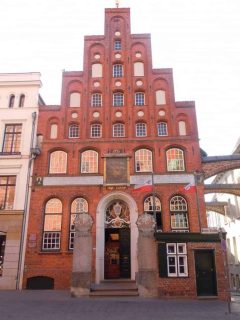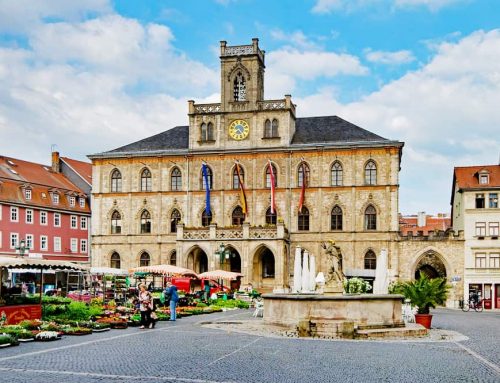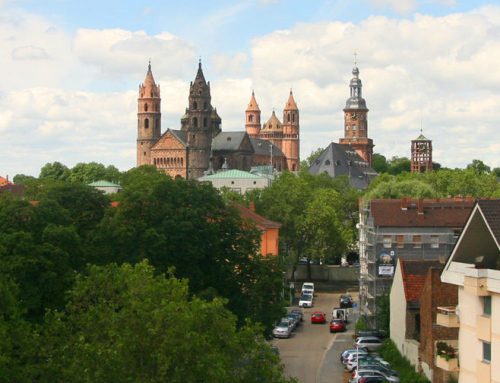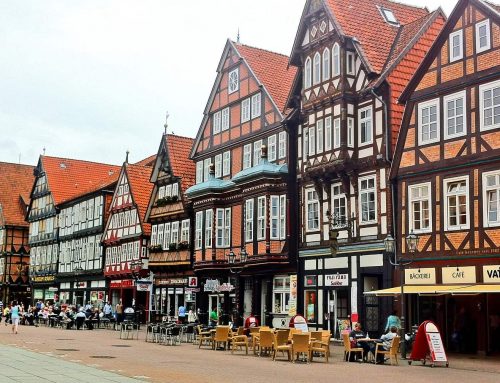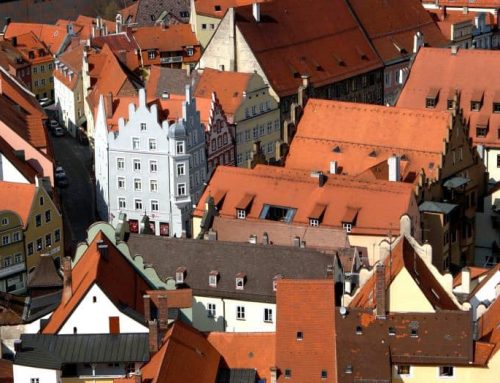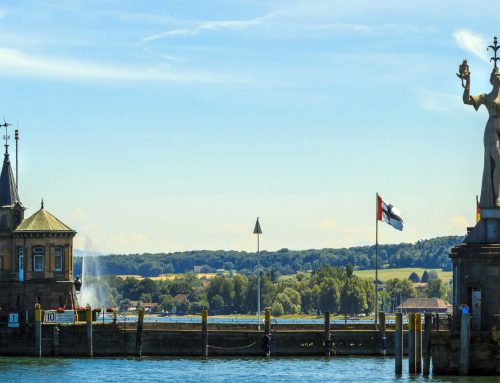Lübeck is one of the finest, most vibrant medieval towns in all of Europe. In the latter part of the Middle Ages, Hansastadt Lübeck was one of Germany’s most important trading cities, and the very hub for the Hanseatic League, which had important branches to Norway, particularly Bergen and Tønsberg. Lübeck is today a very picturesque city with pedestrian streets, cobblestones, pubs, bars and restaurants with outdoor dining in a historic setting that is unmatched anywhere in the world. In 1987, Lübeck was listed on the UNESCO World Heritage List.
[adning id=”36830″]
More about Lübeck
When you wander around Lübeck, you see red. Brick red. It comes from the fact that (almost) the entire city from the Middle Ages until now is built in the building material brick – or Backstein (baking stone – brick is baked into a solid, hard form in ovens), as the Germans call it. This means that large parts of the historic buildings are in so-called “Backsteingotik”, or brick Gothic, as we say.

Panorama of Lübeck’s Altstadt – the city with the 7 towers. Marienkirche with its twin towers sits behind the Marktplatz with the famous town hall. Photo: © ReisDit.no.
This is a direction within the Gothic style that is most common in Northern Europe, although we also find it further south. When you sit in one of the old town’s many squares, you are surrounded by this beautiful architecture. Although much of the buildings were damaged during the Second World War, painstaking reconstruction has produced absolutely brilliant results – Lübeck has also become a very popular tourist destination. The TV series Huset Buddenbrook was based on the novel of the same name, written by the town’s great son, the Nobel Prize winner Thomas Mann.

How to approach Lübeck’s historic center, through the Holstentor – one of the original city gates from the 15th century .
A closer look at Lübeck’s historic centre
Most people who visit Lübeck’s old town enter from the west and pass the Holstentor – the Holsten city gate, which was built in the latter part of the 15th century according to drawings by Flemish architects. Holstentor is today the town’s trademark, which you can find depicted on the packaging of the town’s specialty, marzipan, among other things. Lübeck is situated on a small island, naturally formed as the River Trave splits before the old town and regroups below, before joining the River Wakenitz. Lübeck was thus easy to defend as the river courses formed moats. Lübeck also had access from the Baltic Sea via Trave’s wide course from the city out to the sea.

View of the fine harbor from the bridge at the city gate Holstentor. Notice the beautiful house facades in baroque style, often older houses rebuilt in the 17th century to follow fashion.
More about Lübeck’s historic centre
If you look to the right when you cross the bridge after Holstentor, you will see the harbour. Here it is extremely lively in summer, at the outdoor restaurants along the canal with a beautiful view of buildings from the Middle Ages, the 15th and 17th centuries. Lübeck also has a fantastically beautiful city gate from the year 1444 on the north side of the old town, the high Burgtor in the late Gothic style, with a dome from the 17th century and the Baroque. More about Burgtor in the penultimate section.

Lübeck anno 1552 – very detailed woodcut by Diebel. Source: Wikipedia.
A bit about Lübeck’s early history
Lübeck’s history can be traced back to the 7th century when the city arose as a Slavic settlement – Liubice – along an old trade route that ran from the North Sea north towards the Elbe. The cities of Lübeck, Wismar, Stralsund and Schwerin are located in an area between the rivers Elbe and Oder, which a thousand years ago belonged to the West Slavic tribe Obotrites, also referred to as Vendere, who in the 8th century were allies of Charlemagne due to the threat from Denmark. The oldest parts of Lübeck’s fortifications are dated to the year 816, in the same place where the Burgtor stands today. Lübeck’s name is derived from Liubice, which means “The Beloved”, is first mentioned in written sources by the missionary Adam of Bremen in the year 1076. Liubice was attacked and burned down by another Slavic tribe in the year 1127. Thus, the time had come for German colonization.

< /a> Detail from the handwritten legislation Bardewik Codex – Lübeck’s laws from the year 1294. Source: Wikipedia.
Lübeck becomes German
The German version of Lübeck was founded in the year 1143 by Adolf II von Schauenburg und Holstein. Henrik Løve deprived Count Adolf of his dominion over the city and the surrounding area, after Lübeck burned down in 1157/58. Henrik rebuilt and expanded the city in 1159. In 1160 the city became a bishopric and in 1188 Lübeck came under the Teutonic Roman Empire. Subsequently, Lübeck was conquered by Denmark from 1203 to 1225, but in 1226 came under the emperor again, and received the status of a free city and free trade city in the German-Roman Empire in 1226, which was to mean a lot for the city’s development. Lübeck had meanwhile concluded an important trade agreement with Hamburg, which regulated customs rates and property. The city council now controls who got access to land, as well as duties and rights – a model for the later Hanseatic League. Lübeck is regarded as the first independent city-state in medieval Northern Europe, and as a model for Stockholm’s town plan.

As a safe haven, Lübeck was entitled to strike their own coins – here the Lübecker Goldgulden from the year 1341. Source: Wikipedia.
Hansa period and great prosperity
Lübeck now experienced rapid development and soon became one of Northern Europe’s most prosperous trading cities, due to its good strategic position on the Baltic Sea. Not least, the access to salt from Salzgitter became an important preservative for fish – both from Norway and the Baltic Sea. The trade association, which was initially supposed to regulate trade between the cities along the Baltic Sea, developed over the decades into the powerful Hanseatic League, which had its first official assembly, the “Hansetag”, in 1358. In its heyday in the last half of the 14th century, the Hanseatic League ruled trade in 160 cities across Northern Europe – from England in the west via the Netherlands, Sweden, Norway and Germany, to Riga and Tallinn in the east. When Visby was attacked and destroyed by the Danish king Valdemar Atterdag in the year 1361, Lübeck naturally became the mother city of the Hanseatic League. In 1370, King Valdemar was forced to enter into a peace agreement with the now formalized Hansa confederation through the so-called “Peace of Stralsund”. Lübeck was now Germany’s second largest and most powerful city, after Cologne.

Lübeck anno 1493 depicted in the encyclopedia Nürnberg-krönike. Source: Wikipedia.
From heyday to oblivion
Due to its prosperity, Lübeck was subject to a series of attacks and disturbances throughout the 15th century, and involved itself on the Catholic side in the aftermath of the Reformation in 1517, which was not to pay off. The Danish king Christian III defeated Lübeck in the year 1534, and tried for a short time to rule the city to his own advantage. Although Lübeck soon regained its independence, the city’s power and economy slowly declined. In the year 1615, the city got a completely new fortification, but it didn’t help – the discovery of America and Asia created completely new trade routes and Lübeck ended up in the backwaters. In the year 1669, the last Hanseatic League was held and the Hanseatic League was formally dissolved.

The impressive Burgtor city gate at the north end of Lübeck’s old town also includes a great museum about the Hanseatic period. Photo: © ReisDit.no.
You get the most benefit when you move around the old town on foot. There is an incredible amount to see here, and you will be rewarded if you let your gaze wander both high and low. When you enter the old town, you are surrounded by historic architecture from the first meter, mostly brick buildings, but also half-timbered houses and plastered baroque facades. Perhaps the most beautiful thing is that none of the houses are exactly alike. Many of them have beautiful decorations and some of the half-timbered houses have detailed wood carvings in the beams. Everywhere in Lübeck you will find places to eat, either in the open spaces or indoors – often traditional pubs and restaurants.
[adning id=”36063″]The most important sights from the Middle Ages
One of the first things you notice about Lübeck are the tall church towers, seven in all. When you have passed the first quarter on your way in from Holstentor, the dominant Marienkirche is on your left. Funnily enough, this is bigger than the city’s cathedral, Lübecker Dom. At the back of the nave of this huge Gothic brick church with two towers is the Marktplatz with the city’s famous Rathaus (town hall) from 1226.
The Rathaus is a slightly strange building with a series of spiers around the screen facades with arches. Special, but great. Marktplatz is Lübeck’s most popular meeting place. Both visitors and permanent residents come here to enjoy a sparkling glass surrounded by historic buildings.
The town hall and the other buildings surrounding this beautiful square have arcades. On the market square also stands the original Markt in Gothic style; a small open covered hall with space for stalls around. At the square you also see a stately white building in the Renaissance style, which was previously red brick. Here you will find Ratskeller, one of the city’s better restaurants. Marienkirche is also worth a visit, as here you can see completely unique church art from different eras, including a triptych, a three-part altarpiece, magnificently carved and painted in Antwerp in 1518.

Heiliger-Geist-Hospital is Europe’s most complete of its kind , and has narrow, pointed towers reaching towards the sky on the beautiful Gothic facade.
Heiliger-Geist-Hospital
This unique hospital building from the 13th century is one of the very best preserved of its kind in the whole of Europe. It seems as if the medieval builders of this city were obsessed with towers, even the Heiliger-Geist-Hospital has narrow, pointed minaret-like towers reaching towards the sky on its beautiful Gothic facade. The entire facility is T-shaped and you enter the short end in the west section, the Gothic two-aisled hall church from around 1285, beautifully decorated with ribbed vaults, sculptures and wall paintings.

From the garden of Heiliger- Geist-Hospital where vegetables and fruit were grown for own use. Photo: © ReisDit.no.
Heiligen-Geist-Spital also includes outdoor areas where fruit and vegetables were grown for personal use in the Middle Ages, as well as a beautiful garden. Heiliger-Geist-Spital became a model for other cities’ hospitals in medieval Northern Europe.

The Gothic Jacobi-Kirche from the 15th century is Lübeck’s maritime church and is located right next to the Heiliger-Geist-Spital. Photo: © ReisDit.no.
Only a row of houses away from Heiliger-Geist-Spital is the 15th-century St. Jakobi-Kirche, the maritime church more than any in Lübeck, a beautiful brick church with high spires and whitewashed walls inside. Here is a lifeboat – a so-called Pamir, displayed in it one tower chapel, as a symbol of the connection to those who found their work at sea. Both Heiligen-Geist-Spital, Gertrudenherberge and St. Jakobi-Kirche are also part of the Jakobsweg pilgrimage route to Santiago del Compostela in Spain.

In the St. Annen-Museum in the former Augustinian monastery at St. Annen-Straße 15 you can experience this beautiful altarpiece painted by Hans Memling. Photo: St. Annen Museum.
Augustinian monastery St-Annen
The Augustinian monastery has today been converted into a museum for church art. Here you will find a number of altars, which were ordered by the city’s better-off families for their church chapels. With money, you could buy your own family chapel in one of the city’s five churches, and in that way get extra quick passage through purgatory and from there free access to paradise. Here you will find, among other things, altarpieces by the Flemish Renaissance artist Hans Memling, as well as a beautiful altar carved by the city’s own well-known artist Bernt Notke.
In the St. Annen-Museum you can also see the Wise Virgins, which formerly stood in the Burgkirche. Photo: St. Annen Museum.
A bit about the city’s other medieval churches
Lübecker Dom is a large and beautiful medieval brick Gothic church, completed in the year 1341. This church has a remarkable altarpiece, a 17 meter high cross with Christ, extending towards the ceiling from a dividing wall with Gothic arches. The cross must be carved from a single piece of oak wood. The Museumskirche St Katharinen is a monastery church built by Franciscans in the 13th-15th centuries, and the Jacobikirche, a 15th-century church that was later rebuilt in the Baroque style. Both churches can offer great church art in addition to beautiful architecture with many fine details.
Lübeck’s most important museums
One of Lübeck’s most visited museums is the Heinrich- und Thomas-Mann-Museum, which is housed in the so-called Buddenbrook-Haus, in Mengstrasse opposite the Marienkirche. The Mann family lived here for much of the 19th century, and Thomas Mann wrote the novel with the same name as the building and received the Nobel Prize in Literature for it in 1929. The museum documents the family’s life and the lives of the brothers Heinrich and Thomas, after they 1933 in protest against the Nazi regime left the city and Germany. Another private house that is now a museum is the Schabbelshaus in Mengstrasse 48-50. This house was built around 1560 in Renaissance style and in the 18th century was given a beautiful gildehall in sumptuous Baroque style. The Schabbelshaus is open to the public, as well as housing a restaurant.

From the main street Engelsgrube that runs from St Jacobskirche to the river Trave, you will find many pleasant backyards and alleys with very old buildings. Photo: © reisdit.no.
The modest eastern edge of Lübeck’s old town
While Lübeck is often associated with the merchants’ patrician houses, the old town also has a more modest side, in the eastern part below the city gate Burgertor. Here, the quarters consist of a much more complex building mass, with narrow alleys across backyards and along small patches of garden. Here you will find so-called Höfe, courtyards and yards, with partly very charming buildings and surroundings.
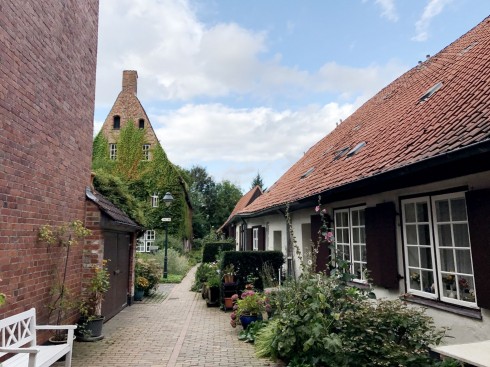
Here from the old town in the east – a home for widows of seafarers listed in the 18th century. Photo: © ReisDit.no.
From the north and the old city gate Burgertor, the Grosse Burgerstarsse runs past the Heiligen-Geist and Jacobi-kirche down to the Marienkirche with its twin towers and the Marktplatz with the Gothic town hall. Opposite Jacobi-kirche you will find the famous skipper’s house “Haus der Schiffergesellshaft” from 1535, which today houses an elegant restaurant of the same name, which you MUST visit if you are in Lübeck. Book a table in advance, the restaurant is very popular. Incidentally, it is in the area around the Marienkirche that the finest patrician houses from the Hansa era are located. Take your time here.

Burgtor was the third city gate you had to pass through in the Middle Ages, before you were allowed into the old town. Photo: © ReisDit.no.
Lübeck’s defense works
Since the medieval city walls were built, there were four entrances to the city center in the old (Roman) fashion, from the north, east, south and west. The paved roads went through Holstentor in the west and Burgtor in the north – both have been preserved for posterity. Through Burgtor, there were a total of three city gates one had to go through to enter the city from the north. Burgtor was the innermost of the three city gates. When you got through the first one to be examined, you were in a pinch, and got nowhere. The same applied to “sluice” number two, before one was more thoroughly examined and was allowed to enter the city itself. Safety was taken seriously, to say the least.
Part from the inside of Burgtor – today’s Hanseatic Museum. Photo: © ReisDit.no.
Burgtor is part of an extensive defense system that was partly rebuilt in the 13th century to also include a monastery. Today, most of the Burgtor complex forms Lübeck’s magnificent Europäisches HanseMuseum. The museum includes, among other things, some magnificent halls and rooms with beautiful wall paintings from the Middle Ages. There is also a separate small department here that represents Bergen, with dried fish and other contemporary interiors.

Beautifully decorated ribbed vaults from the Middle Ages in the Hanseatic Museum in Burgtor. Photo: © ReisDit.no.
The museum is modern with fairly minimalist exhibitions. There is not much information to be found. Audio-visual information can be obtained by placing the ticket at certain points. I personally am not too keen on this way of doing it. There is enough space here to provide a lot of information. In any case, this museum is great and worth seeing, especially the original architecture, which speaks for itself, both towards the sea and towards the city. I wouldn’t be this experience without it.
The neighboring town of Travemünde and ferry connections
From the neighboring town of Travemünde, a beautiful town with a great beach, there is a ferry connection with Trelleborg and Malmö in Sweden and the Finnish capital Helsinki. There are 17 km between Travemünde and Lübeck, and depending on the need, you can stay in one city to visit the other.
Lübeck organizes a Christmas market from the end of November until Christmas Eve. More about it here</a >.
Guides of Europe have been on city walks in Lübeck. Go to the blog here</a > or here, and scroll a little way down the page past Hamburg, to Lübeck.
[adning id=”36063″]
[mappress mapid=”255″]

Rådhusfasaden er i hollandsk renessansestil, med gotisk skjermfasade bak, ved den trivelige møteplassen Marktplatz i gamlebyen.

Den 19. september 1188 signerte keiser Fredrik den 1. Barbarossa et frihetsbrev til Lübeck og området rundt byen. Kilde: Wikipedia.

Keiser Frederik den II. av Det tysk-romerske riket signerte Lübecks andre frihetsbrev. Kilde: Wikipedia.

Etter den daske erobringen mellom 1203 og 1225, ble Lübeck igjen tysk, og fikk et nytt frihetsbrev fra keiseren av Det tysk-romerske riket, denne gangen Barbarossas barnebarn, Friedrich den II. Kilde: Wikipedia.

Lübecks Marktplatz anno 1820 – lite hadde endret seg gjennom de siste 3 århundrene – til venstre det opprinnelige “Markt” i gotisk stil, en liten åpen hall med plass til boder. Kilde: Wikipedia.

Også under renessansen ble det brukt murstein som byggemateriale i Lübecks Altstadt. Foto: © ReisDit.no.

Denne vakre tredelte altertavlen – et såkalt triptyk – finner du i vestenden i Heiliger-Geist-Hospital, innenfor portalen mot gaten.

Det sengotiske hovedalteret i Lübecks Marienkirche kalles ofte “Zwarte-altar mit Madonna” og er laget i Antwerpen i det Herrens år 1518. Legg merke til kisen med solbriller.

Fra et kvartal med meget gammel bebyggelse, sett fra tårnet til St. Petri-kirche. Foto: © reisdit.no.

På innsiden av disse trange Gangene hvor du må bøye deg ned for å komme inn, er det flotte bygningsmiljøer. Foto: © reisdit.no.

Fra Burgtors gotiske spissbuehvelv i den delen av forsvarsanlegget som omfattet et kloster i middelalderen.


